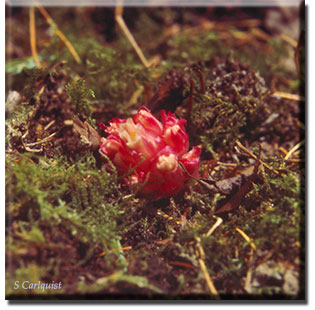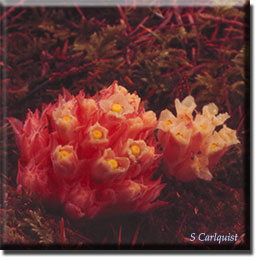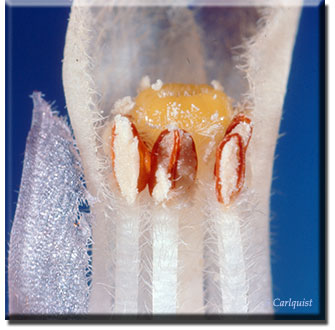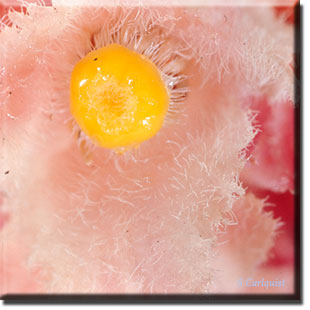Hemitomes congestum
Hemitomes congestum, the so-called Gnome Plant, is one of the rarest of the monotropoids--the group that includes Indian Pipe and the Snow Plant. You're lucky to see Hemitomes. It's rare, and it's small-only three or four cm tall when in flower. Sometimes it's pale pink in color.
Sometimes Hemitomes congestum is rose rather than pink in color. It grows in the leaf litter of conifer forests from central California to Washington. The redwood belt in California is a good place to look for it, but it probably grows on fungi in the leaf litter not of redwoods, but of conifers that grow with the redwoods. Here are two plants of Hemitomes growing next to each other--the large one is rose-colored, the smaller one is more nearly white. Seen from above, the flowers of Hemitomes congestum have four, sometimes five petals (united at their bases), which are fringed and curve outwards. The yellow stigmas are prominent in these flowers. A flower of Hemitomes congestum with two of the petals removed so that the parts of the flower are visible. From top to bottom: the shiny yellow stigma, surrounded by the anthers, now open and shedding pollen; the hairy filaments on which the anthers are borne, and, at the bottom, the knob like nectaries, structures on the ovary that secrete nectar.
The upper portion of a flower of Hemitomes just as it opens reveals that the anthers are still closed, but the yellow stigma is sticky and looks receptive. If this were true, the flower would have to be pollinated by pollen from another flower. That's a way in which cross-pollination between plants could be achieved. Nobody knows what insect pollinates Hemitomes. 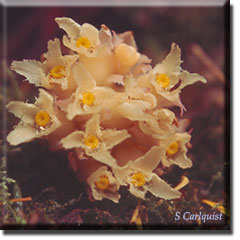 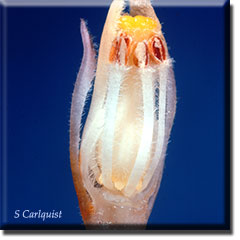 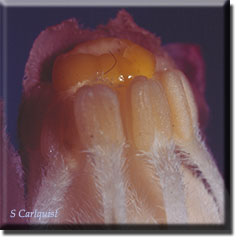
The stamens and stigma of Hemitomes, surrounded by petals. A sepal is at the left. The anthers are shedding pollen grains, which cling together in irregular groups rather than separate. The sticky nature of the pollen grains helps them adhere to hairs on an insect.
A flower of Hemitomes seen from above. The large yellow stigma is conspicuous. The very hairy nature of the inside surfaces of the petals is also evident. Why such a hairy flower? The hairs might keep small insects from climbing down into their flower and robbing the nectar. In that case, we would expect Hemitomes flowers to be pollinated by a long-tongued insect like a moth. The tongue of a moth could reach through the hairs down to the nectar at the bottom of the flower. At the base of the flower of Hemitomes (two petals removed), one can see the knoblike nectaries between the hairy white stamen bases. The nectar secreted by these nectaries forms pools in the bases of the petals. A moth might be able to see the light colored flowers of Hemitomes even under relatively dark conditions. The fruits of Hemitomes congestum are round, white, and fleshy. Because the fruits are fleshy at maturity, presumably they are eaten by some animal, which thereby scatters the seeds in various places in the forest litter. But nobody knows what animal eats the fruits.   |

